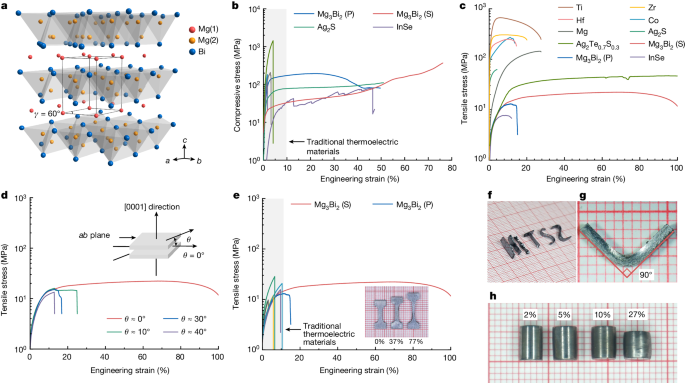Exceptional Plasticity and High Thermoelectric Performance in Single-Crystalline Mg3Bi2 Material
المفاهيم الأساسية
Single-crystalline Mg3Bi2 exhibits exceptional room-temperature plasticity with up to 100% tensile strain, along with high thermoelectric performance, outperforming traditional thermoelectric materials.
الملخص
The content discusses the remarkable properties of the single-crystalline Mg3Bi2 thermoelectric material. Key highlights:
-
Most state-of-the-art thermoelectric materials are inorganic semiconductors with limited plasticity, typically less than 5% tensile strain at room temperature.
-
Experiments reveal that single-crystalline Mg3Bi2 can sustain up to 100% tensile strain along the (0001) plane (ab plane) at room temperature, at least an order of magnitude higher than traditional thermoelectric materials and outperforming many metals with similar crystal structures.
-
The plastic deformation mechanism is identified as the gliding of dislocations, enabled by the material's chemical bonding structure, which provides multiple low-energy slip systems and prevents atomic plane cleavage.
-
In addition to the exceptional plasticity, the tellurium-doped single-crystalline Mg3Bi2 also exhibits high thermoelectric performance, with a power factor of about 55 μW/cm·K^2 and a figure of merit of about 0.65 at room temperature along the ab plane, outperforming existing ductile thermoelectric materials.
إعادة الكتابة بالذكاء الاصطناعي
إنشاء خريطة ذهنية
من محتوى المصدر
زيارة المصدر
www.nature.com
Plasticity in single-crystalline Mg3Bi2 thermoelectric material - Nature
الإحصائيات
Mg3Bi2 can sustain up to 100% tensile strain at room temperature.
The power factor of tellurium-doped single-crystalline Mg3Bi2 is about 55 μW/cm·K^2 at room temperature.
The figure of merit of tellurium-doped single-crystalline Mg3Bi2 is about 0.65 at room temperature.
اقتباسات
"Mg3Bi2 shows a room-temperature tensile strain of up to 100 per cent when the tension is applied along the (0001) plane (that is, the ab plane)."
"Importantly, the tellurium-doped single-crystalline Mg3Bi2 shows a power factor of about 55 microwatts per centimetre per kelvin squared and a figure of merit of about 0.65 at room temperature along the ab plane, which outperforms the existing ductile thermoelectric materials."
استفسارات أعمق
What are the potential applications of this highly ductile and high-performance thermoelectric material in real-world devices?
The exceptional plasticity and high thermoelectric performance of single-crystalline Mg3Bi2 open up a wide range of potential applications in real-world devices. One significant application is in flexible thermoelectric generators for wearable electronics. The high tensile strain of up to 100% along the (0001) plane makes Mg3Bi2 suitable for integration into wearable devices that require flexibility and durability. Additionally, its high power factor and figure of merit at room temperature make it ideal for energy harvesting applications, such as converting body heat into electricity for powering wearable sensors or medical devices. The combination of ductility and thermoelectric efficiency in Mg3Bi2 also makes it promising for use in automotive waste heat recovery systems, where its ability to withstand mechanical stress while maintaining high performance can lead to improved energy efficiency in vehicles.
How do the mechanical and thermoelectric properties of Mg3Bi2 compare to other emerging thermoelectric materials, and what are the trade-offs between these properties?
In comparison to other emerging thermoelectric materials, Mg3Bi2 stands out due to its exceptional combination of mechanical and thermoelectric properties. Traditional inorganic semiconductors often exhibit limited plasticity, with tensile strains of less than five percent, whereas Mg3Bi2 demonstrates a remarkable tensile strain of up to 100% along the (0001) plane. This high ductility sets Mg3Bi2 apart from many thermoelectric materials and even outperforms some metals in terms of plastic deformation. Furthermore, the power factor and figure of merit of tellurium-doped single-crystalline Mg3Bi2 at room temperature surpass those of existing ductile thermoelectric materials, highlighting its superior thermoelectric performance. The trade-offs between these properties lie in the challenge of maintaining both high ductility and thermoelectric efficiency simultaneously, as materials often exhibit an inverse relationship between mechanical strength and thermoelectric performance. However, Mg3Bi2 manages to overcome this trade-off through its unique structural and chemical characteristics.
What are the underlying chemical and structural factors that enable the exceptional plasticity and high thermoelectric performance in Mg3Bi2, and can these principles be applied to the design of other advanced functional materials?
The exceptional plasticity and high thermoelectric performance of Mg3Bi2 can be attributed to several underlying chemical and structural factors. The directional covalent bonding in Mg3Bi2 plays a crucial role in enabling its high tensile strain, as it allows for the gliding of dislocations during plastic deformation. The identification of slip bands and dislocations in deformed Mg3Bi2 indicates the presence of multiple slip systems with low slipping barrier energy, facilitating large plastic deformation. Moreover, the continuous dynamic bonding during the slipping process prevents atomic plane cleavage, contributing to the material's exceptional ductility. These chemical and structural factors can serve as guiding principles for the design of other advanced functional materials with enhanced plasticity and thermoelectric performance. By incorporating similar bonding characteristics and slip systems, researchers can potentially develop new materials that exhibit both high mechanical strength and efficient thermoelectric properties, paving the way for innovative applications in various fields.

